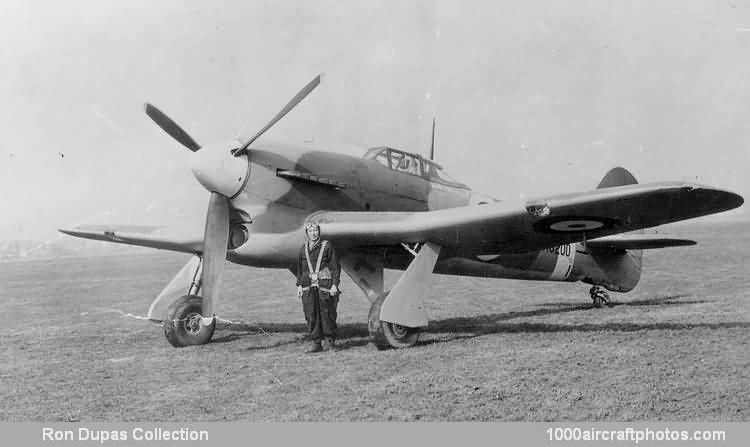10/31/2011. Remarks by Johan Visschedijk: "Sydney Camm and his team responded to Specification F.18/37 which called for a single-seat interceptor, with two tenders. One was referred to as the 'N-type' powered by a Napier Sabre engine (that became the Typhoon) and the other as the 'R-type' powered by a Rolls-Royce Vulture engine (that became the Tornado).
The first of two Typhoon prototypes ordered on August 30, 1938 was flown on February 24, 1940, Gloster Aircraft being allocated production responsibility. Like the Tornado, the Typhoon could be fitted with either twelve 0.303 in (7.7 mm) machine guns (Mk.IA) or four 0.787 in (20 mm) cannon (Mk.IB). The first production aircraft flew on May 27, 1941 with the 2,100 hp Napier Sabre I 24-cylinder H-engine and machine gun armament: about 105 aircraft were to be completed with this armament owing to a shortage of cannon feed mechanisms, but the 2,180 hp Sabre IIA and cannon armament were soon standardized.
The 2,200 hp Sabre IIB and 2,260 hp Sabre IIC progressively supplanted the IIA in the Typhoon, which began to enter squadron service in September 1941. Its disappointing climb rate and extremely poor altitude performance restricted the Typhoon to the low-altitude role, its potential being fully exploited as a ground attack fighter with external ordnance. An original pair of 250 lb (113 kg) bombs was eventually increased to two 1,000 lb (454 kg) bombs or eight 60 lb (27 kg) rockets.
A total of 3,315 production Typhoons was delivered, the last reaching the RAF as late as November 1945. By this time this Hawker fighter had already been largely replaced by the more efficacious Tempest. Some 60 aircraft were fitted with oblique and vertical cameras as Typhoon FR.Mk.IBs, one was tested as a night fighter with an AI Mk.IV radar, and another was tested with an annular radiator.
The pictured aircraft was one of three aircraft donated by Samuel Howard Ellis of Cambridge, New Zealand, it was named "Islands Of Britain" and served with No. 56 Squadron. It was struck off charge on November 16, 1945. The other two aircraft were a Hawker Hurricane, s/n V7776 named "Spirit of the RFC", and a Westland Whirlwind, s/n P7102 named "Comrades in Arms"."
